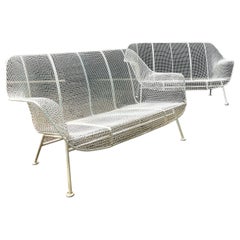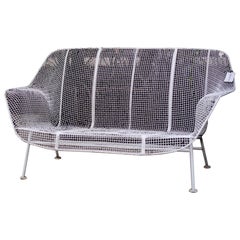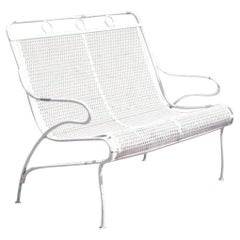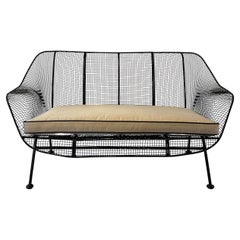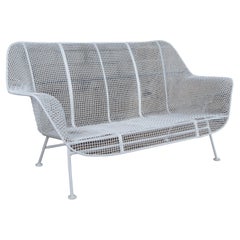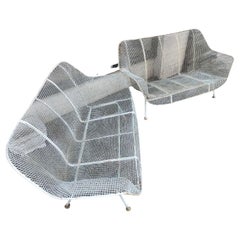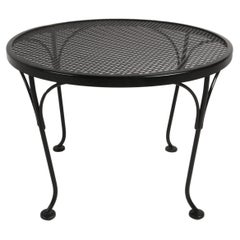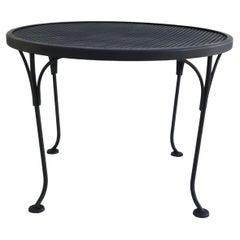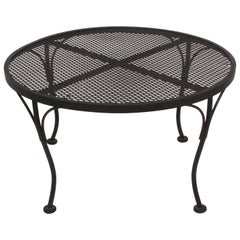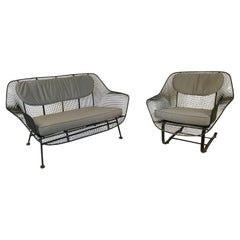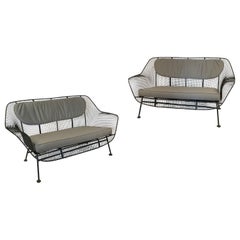Sculptura Settee
Mid-20th Century American Mid-Century Modern Settees
Wrought Iron
Mid-20th Century American Mid-Century Modern Patio and Garden Furniture
Iron
Mid-20th Century Unknown Mid-Century Modern Settees
Wrought Iron
Vintage 1950s American Mid-Century Modern Patio and Garden Furniture
Steel, Wrought Iron
Vintage 1950s American Mid-Century Modern Patio and Garden Furniture
Wrought Iron
Mid-20th Century Mid-Century Modern Patio and Garden Furniture
Metal, Iron
Mid-20th Century Mid-Century Modern Patio and Garden Furniture
Metal, Iron
Vintage 1950s American Mid-Century Modern Patio and Garden Furniture
Steel, Iron
Vintage 1960s American Mid-Century Modern Patio and Garden Furniture
Wrought Iron
Vintage 1960s American Mid-Century Modern Patio and Garden Furniture
Wrought Iron
Vintage 1960s American Mid-Century Modern Patio and Garden Furniture
Wrought Iron
Recent Sales
Vintage 1950s American Mid-Century Modern Patio and Garden Furniture
Wrought Iron
Vintage 1950s American Mid-Century Modern Patio and Garden Furniture
Wrought Iron
Vintage 1950s American Mid-Century Modern Patio and Garden Furniture
Wrought Iron
Mid-20th Century American Mid-Century Modern Settees
Iron
Vintage 1950s American Settees
Wrought Iron
Vintage 1950s American Mid-Century Modern Patio and Garden Furniture
Mid-20th Century American Mid-Century Modern Settees
Metal
Vintage 1950s American Mid-Century Modern Settees
Wrought Iron
Vintage 1950s American Mid-Century Modern Settees
Wrought Iron
Mid-20th Century American Mid-Century Modern Settees
Wrought Iron
Vintage 1950s Patio and Garden Furniture
Iron
Vintage 1950s Patio and Garden Furniture
Vintage 1950s American Living Room Sets
Iron
Vintage 1950s American Mid-Century Modern Patio and Garden Furniture
Wrought Iron
Vintage 1950s American Mid-Century Modern Patio and Garden Furniture
Wrought Iron
Mid-20th Century American Mid-Century Modern Settees
Iron
Vintage 1950s American Mid-Century Modern Patio and Garden Furniture
Steel
Vintage 1950s American Mid-Century Modern Patio and Garden Furniture
Wrought Iron, Wire
Vintage 1950s American Mid-Century Modern Patio and Garden Furniture
Wrought Iron, Wire
Vintage 1950s American Mid-Century Modern Settees
Wrought Iron
Vintage 1950s American Mid-Century Modern Patio and Garden Furniture
Wrought Iron
Vintage 1950s American Mid-Century Modern Patio and Garden Furniture
Iron
Vintage 1950s American Mid-Century Modern Patio and Garden Furniture
Wire, Wrought Iron
Vintage 1950s American Mid-Century Modern Loveseats
Wrought Iron, Wire
Vintage 1960s American Mid-Century Modern Patio and Garden Furniture
Wrought Iron
Vintage 1950s American Mid-Century Modern Settees
Wrought Iron
Vintage 1950s American Mid-Century Modern Patio and Garden Furniture
Vintage 1950s American Mid-Century Modern Patio and Garden Furniture
Vintage 1950s American Patio and Garden Furniture
Wrought Iron
Vintage 1950s American Mid-Century Modern Patio and Garden Furniture
Wrought Iron
Vintage 1950s American Mid-Century Modern Patio and Garden Furniture
Wrought Iron
Vintage 1950s American Mid-Century Modern Patio and Garden Furniture
Wrought Iron
Vintage 1950s American Mid-Century Modern Patio and Garden Furniture
Wrought Iron
Vintage 1950s American Mid-Century Modern Patio and Garden Furniture
Wrought Iron
Vintage 1950s American Mid-Century Modern Patio and Garden Furniture
Wrought Iron
Vintage 1950s American Settees
Vintage 1950s American Patio and Garden Furniture
Vintage 1950s American Mid-Century Modern Patio and Garden Furniture
Vintage 1950s American Mid-Century Modern Patio and Garden Furniture
Vintage 1950s American Mid-Century Modern Patio and Garden Furniture
Vintage 1960s American Mid-Century Modern Patio and Garden Furniture
Iron
Mid-20th Century American Mid-Century Modern Settees
Wrought Iron
Vintage 1950s American Mid-Century Modern Patio and Garden Furniture
Wrought Iron
Vintage 1950s American Mid-Century Modern Patio and Garden Furniture
Wrought Iron
Vintage 1950s American Mid-Century Modern Patio and Garden Furniture
Wrought Iron
2010s Patio and Garden Furniture
Fabric
Vintage 1950s American Mid-Century Modern Patio and Garden Furniture
Wrought Iron
People Also Browsed
Vintage 1960s American Mid-Century Modern Lounge Chairs
Nickel
2010s Italian Mid-Century Modern Table Lamps
Brass
21st Century and Contemporary American Mid-Century Modern Wall Lights an...
Enamel, Brass
2010s Italian Modern Chandeliers and Pendants
Metal, Brass
21st Century and Contemporary American Mid-Century Modern Wall Lights an...
Brass
21st Century and Contemporary Portuguese Modern Benches
Velvet, Wood, Lacquer, Fabric
2010s American Mid-Century Modern Patio and Garden Furniture
Concrete
21st Century and Contemporary Portuguese Organic Modern Side Tables
Travertine
21st Century and Contemporary French Brutalist Night Stands
Oak
2010s Italian Modern Chandeliers and Pendants
Brass
Vintage 1950s French Mid-Century Modern Coffee and Cocktail Tables
Metal
Vintage 1960s English Settees
Velvet
2010s Italian Modern Table Lamps
Brass
Mid-20th Century American Mid-Century Modern Patio and Garden Furniture
Wrought Iron
Vintage 1950s American Mid-Century Modern Patio and Garden Furniture
Metal, Iron
Vintage 1950s American Mid-Century Modern Patio and Garden Furniture
Wrought Iron, Wire
Sculptura Settee For Sale on 1stDibs
How Much is a Sculptura Settee?
Russell Woodard for sale on 1stDibs
Woodard Furniture Company’s diverse offerings have included everything from pine caskets to premium patio and garden furniture over the years.
Lyman E. Woodward founded the family business Woodard Brothers (he dropped the second w for his venture’s name), later Woodard Furniture Co., in Owosso, Michigan, in 1866. Woodard Furniture produced wood furniture such as birch and oak bedroom pieces, window and door blinds and even pine caskets. Demand for the latter increased during the spread of the Spanish flu in America, and Woodard’s casket business — a new company called Owosso Casket Company — thrived, becoming the largest casket manufacturer in the world throughout the 1920s. Two U.S. presidents, William McKinley and Benjamin Harrison, were buried in Owosso caskets.
On the furniture side, Lyman’s son Lee Woodard spun off his own business as Lee L. Woodard and Sons, opening a shop with his sons, Joseph, Lyman II and Russell Woodard. During the 1930s, the new company explored the use of metal in furniture-making and introduced a wrought-iron set of patio dining furniture featuring ornate grillwork inspired by French design called Orleans in 1940. The line became a best seller and kick-started the company’s international reputation as a patio-furniture maker, even as the Woodard factory subsequently shifted toward supporting the wartime efforts in manufacturing parts for trucks and military equipment. After World War II, the business returned to making furniture. Over the years, Woodard and Sons would go on to master metallurgy in furniture making, developing expertise in wrought iron, cast aluminum and tubular aluminum for both indoor and outdoor pieces. In colder regions, wrought iron, which can be left outdoors all year round, was the material of choice in outdoor furniture designs for the Atomic Age, and vintage Woodard outdoor furniture is widely coveted by collectors today.
While the business started with more traditional styles of furnishings, the company would go on to embrace mid-century modernism. In fact, one of Woodard’s most famous pieces is 1956’s Sculptura chair, variously credited over the years to Russell and/or Joseph. The Sculptura was reportedly the first sculpted chair made without molds. Not unlike Harry Bertoia’s elegant steel-wire Side chair (also a mid-century darling) in its undulating form, the Sculptura chair, which is composed entirely of enameled woven wrought-iron wire, bears similarity to Eero Saarinen’s Womb chair for Knoll and Charles and Ray Eames’s DAX chair. The beloved Woodard chair was added to the Cooper Hewitt Smithsonian Design Museum’s permanent collection in 1994.
While the Woodard business is no longer in family hands, the company continues to produce fine patio furniture today and even reintroduced the Sculptura chair in 2015 as nostalgia for mid-century modernism gained steam again.
On 1stDibs, find vintage Russell Woodard lounge chairs, dining chairs and patio furniture today.
A Close Look at Mid-century Modern Furniture
Organically shaped, clean-lined and elegantly simple are three terms that well describe vintage mid-century modern furniture. The style, which emerged primarily in the years following World War II, is characterized by pieces that were conceived and made in an energetic, optimistic spirit by creators who believed that good design was an essential part of good living.
ORIGINS OF MID-CENTURY MODERN FURNITURE DESIGN
- Emerged during the mid-20th century
- Informed by European modernism, Bauhaus, International style, Scandinavian modernism and Frank Lloyd Wright’s architecture
- A heyday of innovation in postwar America
- Experimentation with new ideas, new materials and new forms flourished in Scandinavia, Italy, the former Czechoslovakia and elsewhere in Europe
CHARACTERISTICS OF MID-CENTURY MODERN FURNITURE DESIGN
- Simplicity, organic forms, clean lines
- A blend of neutral and bold Pop art colors
- Use of natural and man-made materials — alluring woods such as teak, rosewood and oak; steel, fiberglass and molded plywood
- Light-filled spaces with colorful upholstery
- Glass walls and an emphasis on the outdoors
- Promotion of functionality
MID-CENTURY MODERN FURNITURE DESIGNERS TO KNOW
- Charles and Ray Eames
- Eero Saarinen
- Milo Baughman
- Florence Knoll
- Harry Bertoia
- Isamu Noguchi
- George Nelson
- Danish modernists Hans Wegner and Arne Jacobsen, whose emphasis on natural materials and craftsmanship influenced American designers and vice versa
ICONIC MID-CENTURY MODERN FURNITURE DESIGNS
- Eames lounge chair
- Nelson daybed
- Florence Knoll sofa
- Egg chair
- Womb chair
- Noguchi coffee table
- Barcelona chair
VINTAGE MID-CENTURY MODERN FURNITURE ON 1STDIBS
The mid-century modern era saw leagues of postwar American architects and designers animated by new ideas and new technology. The lean, functionalist International-style architecture of Le Corbusier and Bauhaus eminences Ludwig Mies van der Rohe and Walter Gropius had been promoted in the United States during the 1930s by Philip Johnson and others. New building techniques, such as “post-and-beam” construction, allowed the International-style schemes to be realized on a small scale in open-plan houses with long walls of glass.
Materials developed for wartime use became available for domestic goods and were incorporated into mid-century modern furniture designs. Charles and Ray Eames and Eero Saarinen, who had experimented extensively with molded plywood, eagerly embraced fiberglass for pieces such as the La Chaise and the Womb chair, respectively.
Architect, writer and designer George Nelson created with his team shades for the Bubble lamp using a new translucent polymer skin and, as design director at Herman Miller, recruited the Eameses, Alexander Girard and others for projects at the legendary Michigan furniture manufacturer.
Harry Bertoia and Isamu Noguchi devised chairs and tables built of wire mesh and wire struts. Materials were repurposed too: The Danish-born designer Jens Risom created a line of chairs using surplus parachute straps for webbed seats and backrests.
The Risom lounge chair was among the first pieces of furniture commissioned and produced by celebrated manufacturer Knoll, a chief influencer in the rise of modern design in the United States, thanks to the work of Florence Knoll, the pioneering architect and designer who made the firm a leader in its field. The seating that Knoll created for office spaces — as well as pieces designed by Florence initially for commercial clients — soon became desirable for the home.
As the demand for casual, uncluttered furnishings grew, more mid-century furniture designers caught the spirit.
Classically oriented creators such as Edward Wormley, house designer for Dunbar Inc., offered such pieces as the sinuous Listen to Me chaise; the British expatriate T.H. Robsjohn-Gibbings switched gears, creating items such as the tiered, biomorphic Mesa table. There were Young Turks such as Paul McCobb, who designed holistic groups of sleek, blond wood furniture, and Milo Baughman, who espoused a West Coast aesthetic in minimalist teak dining tables and lushly upholstered chairs and sofas with angular steel frames.
Generations turn over, and mid-century modern remains arguably the most popular style going. As the collection of vintage mid-century modern chairs, dressers, coffee tables and other furniture for the living room, dining room, bedroom and elsewhere on 1stDibs demonstrates, this period saw one of the most delightful and dramatic flowerings of creativity in design history.
- 1stDibs ExpertNovember 20, 2024To tell if furniture is Woodard, you can look for the maker's markings, as nearly all pieces produced by the company will feature the Woodard name. On seating, you will usually locate a mark embossed on the frame beneath where the cushions go. Tables often have a metal tag on their legs or beneath their tops. If you have difficulty locating a marking, consider having a certified appraiser or experienced antique dealer help you make an identification. On 1stDibs, explore a variety of Woodard furniture.
